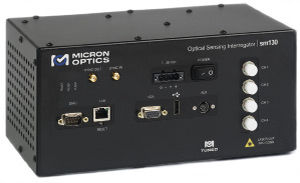
Strain gauge with fiber Bragg grating os3200single-axis


Add to favorites
Compare this product
Characteristics
- Technology
- with fiber Bragg grating
- Geometry
- single-axis
Description
The os3200 Non-metallic Optical Strain Gage is designed to make fiber handling easy and sensor installation fast and repeatable. It is based on fiber Bragg grating (FBG) technology. The os3200 has a self adhesive backing that holds the sensor body in place and protects the FBG while epoxy is injected. The epoxy encapsulates the FBG and bonds it to a structures surface.
Installation time is just a few minutes. Measurements can be taken after the epoxy cures in 24 hours at room temperature.
In side by side comparisons with foil strain gages, the os3200 is equally sensitive and accurate, while providing for greater strain range and 100 times more fatigue life. The os3200 strain gage is qualified for use in mild environments and delivers the many advantages inherent to all FBG based sensors.
This sensor can be used alone or in series as a part of an FBG sensor array. Installation and cabling for such arrays is much less expensive and cumbersome than comparable electronic gage networks. Multiple optical strain gages can be arranged in close proximity at 0, 45 and 90 degrees for strain rosette measurements.
With each sensor, Micron Optics provides a Sensor Information Sheet listing the gage factor and calibration coefficients needed to convert wavelength information into engineering units.
Micron Optics ENLIGHT Sensing Software provides a utility to calculate and then record, display, and transmit data for large networks of sensors. Installation, qualification and other sensor information is available at: http://www.micronoptics.com/support_downloads/Sensors/.
VIDEO
Catalogs
Related Searches
*Prices are pre-tax. They exclude delivery charges and customs duties and do not include additional charges for installation or activation options. Prices are indicative only and may vary by country, with changes to the cost of raw materials and exchange rates.













